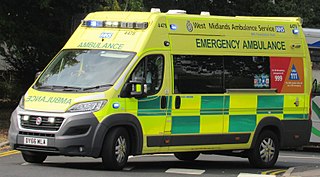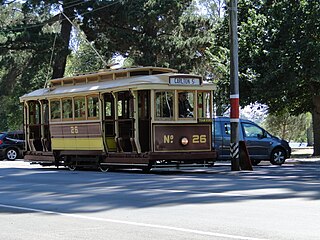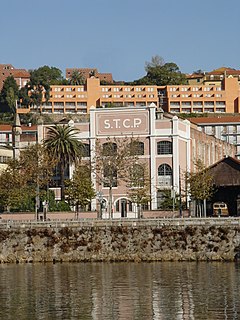
A hearse is a large vehicle, especially an automobile, used to carry the body of a deceased person in a coffin/casket at a funeral, wake, or memorial service. They range from deliberately anonymous vehicles to very formal heavily decorated vehicles.

Light rail transit (LRT) is a form of passenger urban rail transit characterized by a combination of tram and metro features. While its rolling stock is more similar to a traditional tram, it operates at a higher capacity and speed, and often on an exclusive right-of-way. In many cities, light rail transit systems more closely resemble, and are therefore indistinguishable from, traditional underground or at-grade subways and heavy-rail metros.
A streetcar or tram is a vehicle that travels on rails, typically in a street.

An ambulance is a medically equipped vehicle which transports patients to treatment facilities, such as hospitals. Typically, out-of-hospital medical care is provided to the patient.
A double-decker is a vehicle that has two levels for passengers or cargo, one deck above the other. Such vehicles include:

Transport in Chennai includes various modes of air, sea, road and rail transportation in the city and its suburbs. Chennai's economic development has been closely tied to its port and transport infrastructure, and it is considered one of the best infrastructure systems in India.

A combination car was a vehicle that could serve either as a hearse or as an ambulance, and had the capability of being swapped between those roles without much difficulty. This hybrid usage of the cars reflects an era when funeral homes offered emergency ambulance service in addition to their primary trade, especially in smaller towns and rural areas.

Emergency vehicle lighting is one or more visual warning lights fitted to a vehicle for use when the driver wishes to convey to other road users the urgency of their journey, to provide additional warning of a hazard when stationary, or in the case of law enforcement as a means of signalling another driver to stop for interaction with an officer. These lights may be dedicated emergency lights, such as a beacon or a light bar, or may be modified stock lighting, such as a wig-wag or hide-away light, and are additional to any standard lighting on the car such as hazard lights. Often, they are used along with a siren in order to increase their effectiveness.

Stadtbahn is a German word referring to various types of rail transport. One type of transport originated in the 19th century, firstly in Berlin and followed by Vienna, where rail routes were created that could be used independently from other traffic.

A tram accident is any accident involving a tram. Alternatively, any accident involving a tram or a tram system may be considered a tram accident. The latter definition is more commonly used in public safety studies.

The Karlsruhe Stadtbahn is a German tram-train system combining tram lines in the city of Karlsruhe with railway lines in the surrounding countryside, serving the entire region of the middle upper Rhine valley and creating connections to neighbouring regions. The Stadtbahn combines an efficient urban railway in the city with an S-Bahn, overcoming the boundary between trams and trains. Its logo does not include the green and white S-Bahn symbol used in other German suburban rail systems and the symbol is only used at stops and stations outside the inner-city tram-operation area.

Dundee Corporation Tramways formerly served the City of Dundee in Scotland. The Corporation had financed the construction of a horse tramway in 1877, but had then leased it to the Dundee and District Tramways Company. They had replaced most of the horse trams with steam tram locomotives pulling trailer cars from 1884, but in 1897 the Corporation decided that it would run the tramway system itself. After some negotiation and the payment of compensation, they took over the system in 1899, with a view to electrifying it. Electric trams started running in 1900, and the changeover was completed in 1902.

The Huntsville Hospital Tram System is an automated people mover system located as part of the Huntsville Hospital System complex in Huntsville, Alabama, United States. Operating on a 1,890-foot (580 m) concrete guideway, the trams serve to connect the Huntsville Hospital with the Huntsville Hospital for Women & Children. At the time of completion, this was the second hospital people mover system in the United States after the Duke University Medical Center Patient Rapid Transit. As of January 2010, this is the only automated people mover system completed in the state of Alabama.

High-floor describes the interior flooring of commuter vehicles primarily used in public transport such as trains, light rail cars and other rail vehicles, along with buses and trolleybuses. Interior floor height is generally measured above the street surface or above the top of the rail. High-floor designs usually result from packaging requirements: mechanical items such as axles, motors, crankshafts, and/or transmissions, or luggage storage spaces are traditionally placed under the interior floor of these vehicles. The term is used in contrast with low-floor designs, which offer a decreased floor and entry height above the street surface. Since low-floor designs generally were developed after high-floor vehicles, the older high-floor design is sometimes also known as conventional or the “traditional” design.
Rapid response vehicle, can mean:

The British Rail Class 399 is a type of rail vehicle built by Vossloh on its Citylink platform for operation by Sheffield Supertram. While it is a low floor tram, it is also capable of being used upon the National Rail network; the Class 399 is the first tram-train to see operational use in the United Kingdom.

The M-class was a class of 17 trams built by Duncan & Fraser, Adelaide for the Hawthorn Tramways Trust (HTT) as numbers 1 to 10, and 33 to 39. All passed to the Melbourne & Metropolitan Tramways Board on 2 February 1920 when it took over the Municipal Tramway Trusts, becoming the M-class and being renumbered 107 to 116, and 183 to 189.
A hearse is a type of funerary vehicle.

The Porto Tram Museum(Museu do Carro Eléctrico) is a museum operated by the Sociedade de Transportes Colectivos do Porto. It was inaugurated in 1992 and is installed in a former thermoelectric power station next to the River Douro in Massarelos, Porto, Portugal. It exhibits material related to the history of trams in Porto. The collection contains 16 electric cars, 5 trailers, and two maintenance vehicles as well as the former equipment of the power plant, which provided electricity for the tram lines.
Trams have been used since the 19th century, and since then, there have been various uses and designs for trams around the world. This article covers the many design types, most notably the articulated, double-decker, drop-centre, low-floor, single ended, double-ended, rubber -tired, and tram-train; and the various uses of trams, both historical and current, most notably cargo trams, a dog car, hearse tram, maintenance trams, a mobile library service, a nursery tram, a restaurant tram, a tourist tram, and as mobile offices.














